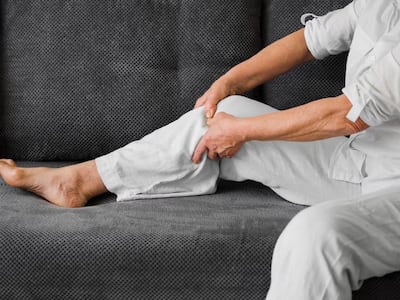
Critical limb ischemia (CLI) is the end stage of Peripheral artery disease (PAD). Left untreated, it can result in limb amputation. Stem cell drug Stempeucel is a new and effective treatment for CLI.
Do you feel a burning pain in the lower leg or foot when you’re resting or lying down? This is a typical symptom of Peripheral artery disease (PAD), which results when the arteries that supply blood to the limbs become narrowed or blocked, reducing blood supply. If the condition progresses, one may experience chronic ischemic rest pain, also called critical limb ischemia (CLI), which can lead to limb amputation, if left untreated.
Stempeucel, a drug made from stem cells derived from the bone marrow, is touted as an effective treatment for Critical Limb Ischemia (CLI). Dr. (Lt. Col) Pawan K Gupta, President Medical & Regulatory Affairs at Stempeutics Research, sheds light on the causes of Critical Limb Ischemia and how stempeucel is better than the existing treatment for CLI.
Q. What is Critical Limb Ischemia?
Peripheral artery occlusive disease (PAOD), also commonly known as peripheral artery disease (PAD), is a manifestation of atherosclerosis caused by obstruction of peripheral arteries. Critical limb ischemia (CLI) is the severe subset and end stage of PAD which is characterised by severe rest pain, non-healing ischemic skin lesions and finally gangrene of the extremity due to inadequate blood supply to the limb. If no therapeutic intervention is made during this stage of the disease the inevitable outcome is limb amputation.
Q. What are the causes and risk factors of Critical Limb Ischemia?
The blockage of arteries is primarily due to atherosclerosis; although in Mediterranean and Asian countries this can be due to Thromboangitis obliterance (TAO) or Buerger’s disease which has shown to be strongly associated with tobacco use. Other causes include various autoimmune disorders like Systemic Lupus Erythematosus (SLE), and acute conditions like embolism. The prevalence of PAD has been estimated to be around 27 million in Europe and North America. It is approximately 3% to 12% of general population and increases with age. Buerger’s disease accounts for a variable proposition of patients with peripheral vascular disease throughout the world: 0.75% in North America, 0.5% to 5.6% in western Europe, 16% to 66% in Korea and Japan, 45% to 63% in India, and 80% in Israel among Jews of Ashkenazi descent.
Various risk factors causally related to PAD include diabetes, hyperlipidemia, hypertension and smoking. Coexistent coronary artery disease (CAD) and cerebrovascular disease (CVD) are highly prevalent in patients with PAD particularly in elderly population.
Q. How is Critical Limb Ischemia treated and what are the existing treatment options?
The management of CLI is based on risk factor management and surgical or endovascular revascularization aiming to improve blood flow to the affected extremity. Most patients with CLI are managed with analgesics, antiplatelets and cilostazol in addition to lipid lowering drugs. If revascularization has failed or is not possible, major amputation is often necessary. Approximately 10% of CLI patients will undergo primary amputation with healing rates varying from 30% and 90%, and re-amputation rate stands between 4% and 30%. Overall, approximately 40% and 50% of CLI patients will lose their leg within 6 12 months and approximately 15% will also require contralateral amputation within 2 years. In CLI patients, cardiovascular cause of mortality increases substantially with approximately 20% of patients dying during first 6 to 12 months after CLI onset, and 2 -, 5 and 10 year mortality rates of approximately 35%, 70% and 100% respectively. It has therefore become urgent to conceptualize and develop new modalities of therapy that will induce revascularization including neoangiogenesis and remodel the vascular system to prevent the complications of CLI, thus improving limb salvage and increasing the overall survival of these patients.
Q. What makes Stempeucel better than other treatment options for Critical Limb Ischemia?
Stempeucel possess anti-inflammatory and immunomodulatory properties, apparently by inhibiting tumour necrosis factor alpha (TNF ) and interferon gamma (IFN-gamma) and by increasing interleukin 10 (IL 10), indolamine 2,3 deoxygenase (IDO), prostaglandin E2 (PG E2)and nitric oxide (NO). This unique immunomodulatory property makes these cells suitable for both autologous and allogeneic use, since they avoid rejection of the transplant.
In regard to their therapeutic potential, it is now accepted that the myriad of growth factors and cytokines secreted by the Stempeucel in vitro and in vivo are critical for their therapeutic activity. These cells secrete known mediators of tissue repair including various growth factors, cytokines and chemokines. The major immunomodulatory cytokines include prostaglandin 2, transforming growth factor-beta 1 (TGF- 1), hepatocyte growth factor (HGF), stromal derived factor 1 (SDF-1), NO, IDO, IL-4, IL-6, IL-10, IL-1 receptor antagonist and soluble tumour necrosis factor- receptor. Besides, secreted vascular endothelial growth factor (VEGF), insulin-like growth factor-1 (IGF-1), EGF and angiopoietin-1 (Ang-1) are released to recruit endothelial lineage cells and initiate vascularization. Stempeucel also express mitogenic proteins such as TGF- , TGF- , HGF, epithelial growth factor (EGF), basic fibroblast growth factor (FGF-2) and IGF-1 to increase fibroblast, epithelial and endothelial cell division. These important factors are known to play a key role in angiogenesis and act via paracrine pathway. Both VEGF and angiopoietins (Ang 1 and Ang 2) play a crucial role in the process of neoangiogenesis. While Ang 1 and Ang 2 participate in the “stabilization” of the newly formed vessels, VEGF exerts its pro angiogenic function by binding to one of its receptors specifically the VEFG receptor 2 or kinase (VEGFR2 or KDR) insert domain receptor, expressed exclusively by endothelial cells (ECs) and their precursors. This binding triggers a cascade of events leading to the formation of new blood vessels including recruitment of support cells such as pericytes for small capillaries and smooth muscle cells for larger vessels.
Stempeucel have also been shown to possess anti-inflammatory, anti-apoptotic, anti-fibrotic, mitogenic and wound healing properties. The anti-inflammatory properties of Stempeucel may be primarily responsible for the marked benefit of these cells in Buerger’s disease, which is primarily an inflammatory disease affecting small and medium sized arteries. As Stempeucel treats the root cause of the disease with neoangiogenesis, repair of the damaged muscles and decrease in rest pain due to its anti-inflammatory and immunomodulatory properties, treatment with stempeucel is far more superior than the existing treatment for CLI.
Q. Tells us more about Stempeucel, the ingredients used, how it works and its efficacy.
Stempeucel is a suspension of 150 or 200 million adult human bone-marrow derived, cultured, pooled allogeneic mesenchymal stromal cells and conforms greater than 90% positivity for BMMSC’s associated markers CD73, and CD105 and does not express CD34 and CD45, and is also negative for co stimulatory molecules. The stempeucel also efficiently differentiates in vitro to osteogenic, chondrogenic and adipogenic cells and also possess a strong immunomodulatory/ immunosuppressive and anti-inflammatory activity in vitro and is non-immunogenic in nature. The stempeucel is capable of secreting a variety of bio active factors with diverse functional activity especially those that have been implicated in angiogenesis such as VEGF, TGF- , HGF, Angiopoietin 1 and 2, and IL-8 among others. In particular, VEGF secreted by stempeucel has been shown to cause, the migration, proliferation and angiogenesis of endothelial cells in vitro. The strong angiogenic and immunomodulatory activities exerted by stempeucel indicate that these cells can be of therapeutic value in treating CLI patients.
READ RELATED: Black Tea: What Happens To Your Body If You Drink This Beverage For A Month?
Stempeucel is safe and efficacious and offers an alternative to the existing treatment:
- In both pre-clinical and clinical studies conducted stempeucel is found to be safe.
- 184 patients enrolled in CLI phase I/II, CLI phase II trial due to Buerger’s disease, CLI phase III trial due to atherosclerotic PAD and CLI phase IV study due to Buerger’s disease no SAE related to IMP
- Pre-clinical studies in animal model of CLI shows that it has potential therapeutic application in ameliorating ischemia induced limb necrosis and muscle degeneration, ultimately leading to limb salvage.
- In clinical trials (in phase I/II, phase II & phase III) and phase IV PMS study
a. In phase II trial showed significant improvement in relief of rest pain (p=0.0193) & healing of ulcers (p=0.0253). In phase III trial it also showed significant improvement in relief of rest pain (p<0.0001) & healing of ulcers (p<0.0001). In phase IV PMS study, it also showed significant improvement in relief of rest pain (p<0.0001) & healing of ulcers (p<0.0001).
b. In phase II trial, there was evidence of increased blood flow in lower limbs as seen in improvement in ankle systolic pressure (p=0.0040) and ABPI (p=0.0132) [seen in phase I/II also], In phase III trial, there was also evidence of increased blood flow in the lower limbs as seen in improvement in ankle systolic pressure (p<0.0001) and ABPI (P<0.0001). In phase IV PMS study, it also showed significant improvement in ankle systolic pressure (p<0.0001) and ABPI (P<0.0001).
c. In phase III trial showed improvement in Quality of life total score and its 5 domains physical activity, symptom, pain, emotional and social activity (all p<0.0001) (improvement also seen in phase II trial)
d. In phase III trial showed improvement in total walking distance (p<0.0001) (improvement also seen in phase II trial).
e. Stempeucel has shown clinical benefit objectively, with increased blood flow in lower limbs with no safety concern in all the trials conducted – Phase I/II, Phase II, Phase III & Phase IV clinical trial.
In India, Stempeucel CLI is marketed under the brand name Regenacip, by Cipla, a pharmaceutical company.
Total Wellness is now just a click away.
Follow us on
Don’t Miss Out on the Latest Updates.
Subscribe to Our Newsletter Today!
window.addEventListener(‘load’, (event) => {
$(‘#commentbtn’).on(“click”,function(){
(function(d, s, id) { var js, fjs = d.getElementsByTagName(s)[0]; if (d.getElementById(id)) return; js = d.createElement(s); js.id = id; js.src = “//connect.facebook.net/en_US/sdk.js#xfbml=1&version=v2.3”; fjs.parentNode.insertBefore(js, fjs);}(document, ‘script’, ‘facebook-jssdk’));
$(“.cmntbox”).toggle();
});
});









